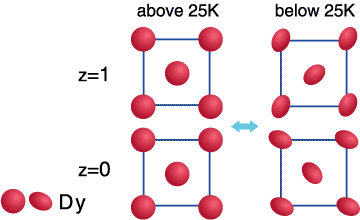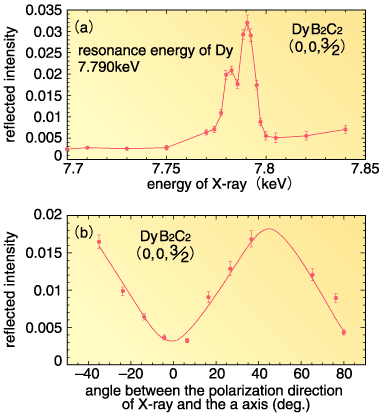A number of transition metal ions, such as Mn2+, Fe3+, Sm3+, Nd3+, etc, have a magnetic moment (= magnetic dipole moment), and the spontaneous arrangement of the dipole moment is the so-called magnetic order. These ions often possess another degree of freedom, the electric quadrupole moment. The spontaneous arrangement of this quadrupole moment is called quadrupole order, and materials which contain rare-earth elements particularly show this type of ordering. The quadrupole order, especially antiferro-quadrupole order, indicates little change in macroscopic properties, hence the quadrupole moment is known as a "hidden order parameter''.
In the quadrupole ordered state, the electronic charge distribution of the atom has a low symmetric shape compared to that of the disordered state. For instance, in DyB2C2, where dysprosium (Dy) is the rare-earth element and has the quadrupole moment, the electronic distribution of the Dy atom changes at 25K as shown in Fig. 4-11. X-rays can observe the change of symmetry.
An atom has its own resonant energies. When the energy of the X-rays is tuned to one of those resonant energies, the intensity of X-rays scattered from the resonant atom is a function of the relative angle between the polarization direction of the X-ray and the principle axis of the distorted electronic distribution. We utilize this phenomena.
Since X-rays are waves, one can choose an incident angle of the X-ray to the crystal so that the periodicity of the X-ray coincides with that of the quadrupole order. Under this condition, the reflected intensity of the X-ray has a strong enhancement at the resonant energies (Fig. 4-12(a)) and shows a large oscillation as a function of the polarization direction of the incident X-ray relative to the a axis of the DyB2C2 crystal (Fig. 4-12(b)). This is strong evidence of anisotropic charge distribution on the Dy ion.
Making use of synchrotron radiation, which has great advantages in energy tunability and highly linear polarization, we observed energy and polarization dependence of the reflected X-ray from the quadrupole ordered DyB2C2, as shown in Fig. 4-12. We also deduced the lattice distortion pattern from the simple structural analysis. From these results, it is unambiguously concluded that quadrupole order shown in Fig. 4-11 is actually realized in DyB2C2. |


